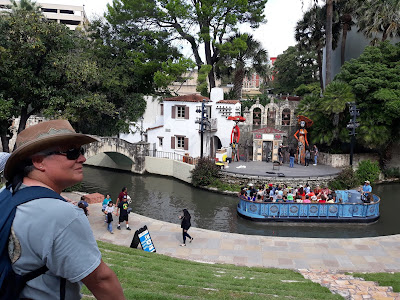River Walk, San Antonio, Texas - Friday, 26 October 2018
 |
| From our campground we had direct access to the River Walk bike path in San Antonio. We stowed our hats in our backpacks and wore our helmets while we biked along for a couple miles. |
 |
| Dia de las Muertas (Day of the Dead) masks and family tents honoring deceased relatives lined some streets. |
 |
| Every shop and restaurant had decorations for Halloween too. |
 |
| A local mariachi band plays for restaurant customers. I don't know enough Spanish to translate but it was still enjoyable to listen to the lively music. |
Driving School, San Antonio, Texas - Tuesday, 30 October 2018
San Antonio Missions, San Antonio, Texas, Wednesday, 31 October 2018
 |
| Santa Maria de Guadalupe statute outside the chapel. |
 |
| An interesting addition to he mission wall below the bell tower. |
 |
| The chapel is set lengthwise to the mission bell tower. A simple design which allows the chapel walls to be integrated into the compound walls. |
 |
| Even today, native families continue to use this mission chapel for services and it is staffed by on-site Franciscans since 1967. |
 |
| Some say the broken arch over the Mission Espada doorway is a builder's mistake, but many parishioners find beauty in the unexpected inversion of the standard Spanish style lines. |
 |
| Simple furnishings for a local community with a rich history. |
 |
| The main ditch continues to carry water to the mission and its former farm land and is still used by the residents living on the neighboring lands. |
 |
| Our very animated tour guide explaining the use of the open archway system. |
 |
| This is the largest of all the San Antonio missions and, as with all but the Alamo, continues to provide services to the local decedents of the original mission residents. |
 |
| The small domes behind the Rose Window cover the side door walkway for the priests to access their living quarters. |
 |
| This is a representation of the original facade decoration. |
 |
| A lovely hibiscus still flowering in the warm days of San Antonio. |
 |
| The tusks are 11 feet long. |
 |
| Artist's conception of the nursery herd. |
 |
| The remains of a prehistoric camel which roamed with the nursery herd. It provided good vision to see predators from afar and in return, it received protection from the herd. |
 |
| Compare the standard human with an accompanying femur bone to the mammoth femur (replica). |


















No comments:
Post a Comment